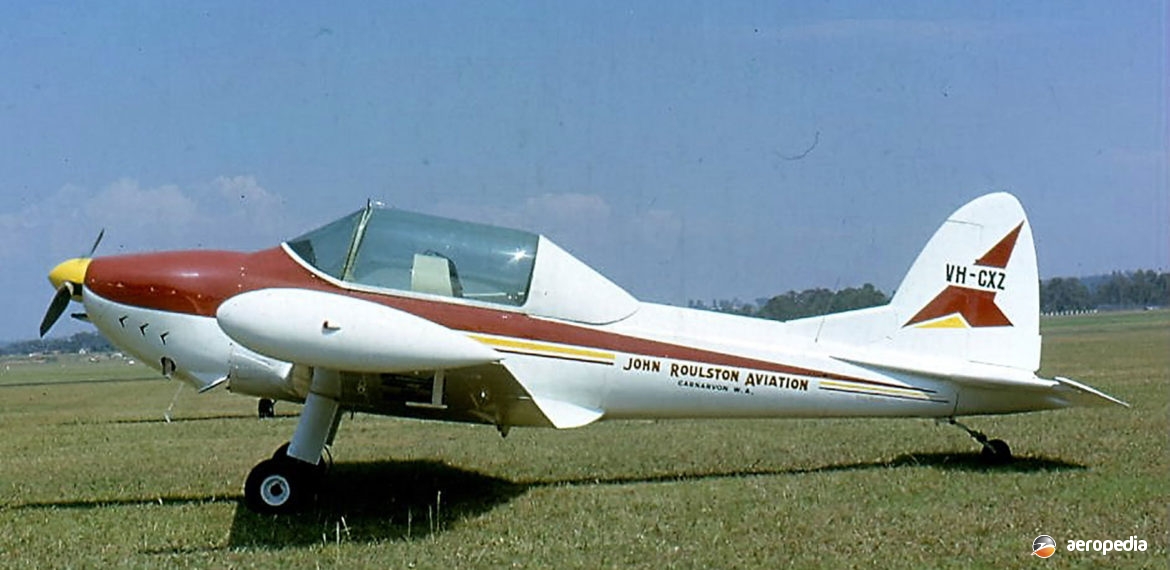Photograph:
The prototype Aerostructures Sundowner VH-CXZ (c/n C1/0486) at Bankstown, NSW in 1967 (David C Eyre)
Country of origin:
Australia
Description:
Two-seat low-wing sport monoplane
Power Plant:
One 134 kw (180 hp) Lycoming O-360 four-cylinder horizontally-opposed air-cooled engine
Specifications:
- Wingspan: 10.47 m (34 ft 4 in)
- Length: 7.82 m (25 ft 5 in)
- Height: 2.13 m (7 ft)
- Wing area: 15.98 m² (172 sq ft)
- Cruising speed at 65% power: 185 km/h (115 mph)
- Rate of climb: 344 m/min (1,130 ft/min)
- Take-off run to clear 15 m (50 ft) obstacle: 305 m (1,000 ft)
- Landing run to clear 15 m (50 ft) obstacle: 335 m (1,100 ft)
- Range at 65% cruising speed at sea level: 1,287 km (800 miles)
- Empty weight: 612 kg (1,350 lb)
- Loaded weight: 953 kg (2,100 lb)
History:
Aerostructures was a company known for some years for modifying aircraft to increase performance for operators, aircraft conversions including the Cessna 172, 175 and 210, and customising other types. The Company also developed a Skiplane, this being a glider towed behind a boat. The Company moved on to develop a modernized variant of the Chipmunk, using the wings, fuselage and tail but basically building a new aircraft. In 1966 Aerostructures announced it proposed to convert a number of Chipmunks to Lycoming power, the first model proposed to be known as the Sundowner fitted with a 134 kw (180 hp) Lycoming O-360 engine.
First aircraft to be converted was VH-RNJ (c/n CI-0486 – ex G-AOUC), using the fuselage of this aircraft and the wings of an ex-British machine G-AOUC (ex WG412), the conversion commencing ground running tests of the engine in June 1967. It was painted overall white with brown and yellow trim. It was allocated registration VH-CXZ for testing, although this was never formally taken up.
The Department of Civil Aviation required a new Type Certificate with the more powerful engine and metal wing covering in lieu of fabric. Completed in March 1968, and after a number of test flights, problems arose with the paper work and, after being parked in the open at Bankstown, NSW for some time, the aircraft was exported to the United States in 1973 where it became N8DW.
The conversion included metallising the fabric covered sections, etc, and wing-tip fuel tanks with a capacity of 82 litres (18 Imp gals) which needed to be empty for aerobatics. The tip tanks could be removed and replaced with the original wing tips or end plates. Stalling speed was said to be lower, with an electric stall warning indicator replacing the wing-root buffet strips. The engine cowlings were two-piece and constructed from fibreglass.
The Sundowner, in order to save on manufacturing costs, used as many parts as possible from the Sasin SA-29 Spraymaster. Initial proposal was to produce two models, the Sundowner for private use, this aircraft being aerobatic, and the Musterer, this latter model being almost identical to the Sundowner but with modifications ordered by North West Air Taxis of Carnarvon, WA, this company in 1966 being said to have ordered a fleet of what was to be known as the A-103 Musterer for rounding up sheep and cattle in northern Western Australia.
North West Air Taxis was reported to have considered the modified aircraft to be the right aircraft for its operations, having previously used a Chipmunk VH-UEZ (c/n CI-0055 – ex VH-BWC) for this work. However, the order for the Musterer was cancelled.
The manufacturers found that the construction of the Spraymaster and the Sundowner was not economical and moved on to only carrying out conversions of aircraft submitted by their owners.
In 1968 work commenced on a second Sundowner VH-RJK (c/n CI-0066 – ex VH-RVT, WB625) owned by Dr L McDonnell of Sydney, NSW. Because of the problems that had been experienced with the certification of VH-CXZ, the rebuild of VH-RJK was limited, the cockpit area being left un-modified and the wingtip fuel tanks not being installed. It was completed and painted white and bronze with the name Sundowner on the side, appearing on the Civil Aircraft Register as a DHC-1 A1.
Subsequently VH-RJK appeared at a number of aviation events, with similarly converted VH-RSQ, operated by Aerial Promotions Pty Ltd of Sydney. VH-RJK was fitted with a long-range under-fuselage belly tank and night VMC equipment and continued to fly with that company until sold in December 1974 to the Gliding Club of WA, taking up residence at Cunerdin. It remains on the Civil Register. VH-RSQ was eventually exported to the United States as N640WB.

